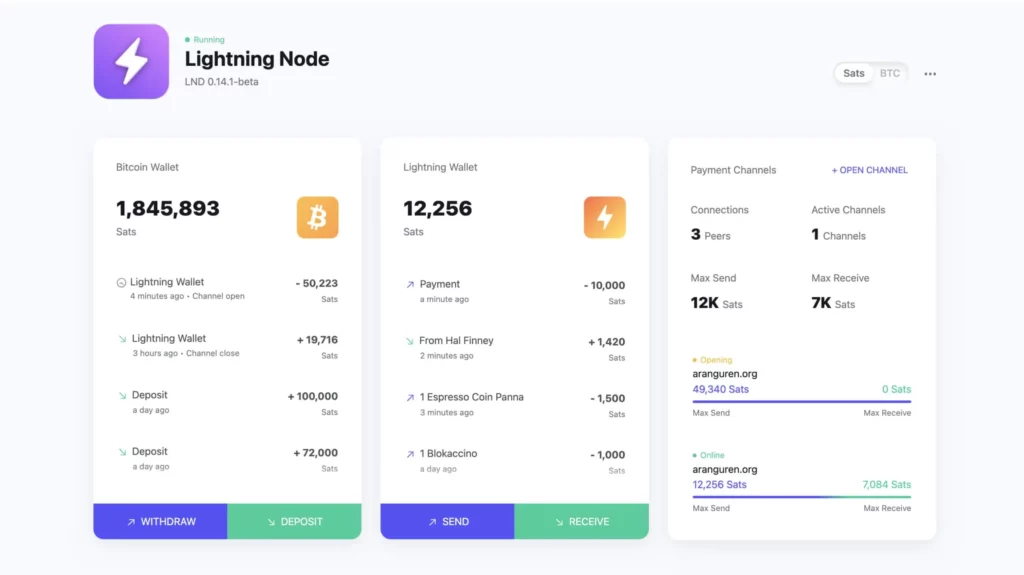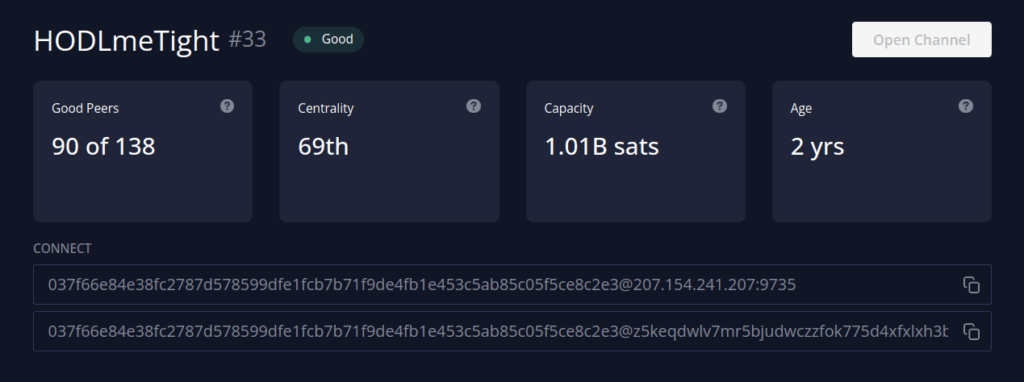Living the dream while your Lightning Node earns you that sweet, sweet passive income has been an idea ever since the Lightning Network started. So after running our own node for multiple years now, we’re going to discuss whether or not running a Lightning Node is profitable, what Lightning Node profitability you can expect, analyze its return on investment capabilities and finally give you a full run down of what to expect with this investment strategy.
Contents
What Is A Bitcoin Lightning Node?
A Bitcoin Lightning Node (also sometimes called a Lightning Network Node or a LN Node) is just a computer that runs special software that allows it to connect to the Lightning Network. It can send and receive Lightning payments as well as route other peoples Lightning payments. For example, you could use your Lightning Node (and Lightning Wallet) to purchase a coffee if the store accepted Lightning payments.
The Lightning Network is a Layer 2 network that sits on top of the Layer 1, Bitcoin Network and uses the same currency, BTC or bitcoins. We have an entire deep dive into the Lightning Network, but in short it allows for instant and near free payments that are final (like cash), is completely borderless and can even send payments as small as 1 Satoshi.
It’s common for those that run a Full Bitcoin Node to also install the software that enables it to also become a Lightning Node. There are numerous pre-built and configured Lightning Nodes out there such as:
You can also just use any old or new computer and install various free software packages yourself. Many people run their own Full Bitcoin Node and Lightning Node on a Raspberry Pi 4 8GB or a small form factor PC such as a Dell OptiPlex or even Mac Mini with:
We’ve even created a full, step-by-step guide that outlines how you can buy, build and setup your very own full Umbrel Node for around $300.
Benefits Of Running A Bitcoin Lightning Node
So why would anyone go to all the trouble of running a node? Well besides being able to refer to yourself as a “Node Runner” (who doesn’t like Blade?) there’s other core benefits including:
- Help Secure The Bitcoin Network: By running a Full Bitcoin Node you help increase the decentralization of the Bitcoin Network and become a fully fledged self sovereign individual
- Increased Security & Privacy: As noted in our Advanced Bitcoin Security and Advanced Bitcoin Privacy guides, running your own full node gives you the best level of security and privacy. It’s your node, running the code you choose and no one can take that away from you, spy on you or feed you false information
- Accept Lighting Payments: When you run your own Full Bitcoin Node and Lighting Node you can accept both Bitcoin and Lightning payments from anyone, anywhere in the world at any time. You can receive payments for a business you run, accept donations like we do or do anything else that involves sending or receiving payments. You’re your own bank and payments processor now!
- Increase Lightning Networks Liquidity & Reach: As the Lightning Network is a network, its usefulness and liquidity increases each time a new node is added. Just like a new telephone increases the usefulness of the telephone network for everyone, adding another node increases its reach and amount of value that can be transferred
- Host Lightning Wallets For Friends & Family: You can setup your friends and family with their own Lighting Wallet that connects directly to your Lightning Node. This gives them the best privacy and security without them having to setup anything
- No Trusted 3rd Parties: As your Lightning wallet connects directly to your Lightning Node, you don’t have to trust any third parties to custody your bitcoins
- Learn About Lightning: Through setting up and managing the Lightning Node you will gain experience and understanding of both the Bitcoin and Lightning network. This could be used to help others, get a job in the industry or just expand your knowledge
Last, but not least, is that you can actually earn money (bitcoins) by running a Lightning Node and routing other peoples payments through your channels. For example, if you route a Lightning payment that’s worth 100,000 sats you might charge 0.05% as a fee meaning you’d earn 50 sats.
This all happens automatically once the channels are setup and could be considered a somewhat Passive Income stream. You can open dozens of channels, connect to hundreds of other nodes and route thousands and thousands of payments per month if you’re dedicated enough, potentially leading to some decent returns.
How To Run A Lightning Node

Running a Lightning Node is itself, a pretty deep rabbit hole we must admit. While the custom built full node solutions by makers such as Umbrel have made the setup part as trivial as buying and plugging in an iMac, there’s a lot more to it.
When you first boot up your Lightning Node you’ll need to first wait for the Bitcoin Blockchain to fully download and sync. After that’s complete you’ll need to setup one or more Lightning Channels. These are links out to other Lightning Nodes on the network. It’s these channels that payments are sent and received over similar to how you send an email over your Internet connection to Gmail.
How you configure these channels and who you peer with is more of an art than science. There are major players you can connect to such as ACINQ, Bitfinex or River that run huge Lightning Nodes with hundreds of peers. Or you can simply connect to other plebs, your family and friends or even random strangers you find on forums.
In time we’ll be adding full guides on how to setup your own Lightning Node, step-by-step instructions on how to configure Lightning Channels and even reviews of the various different Node Software that’s out there. Suffice to say, running a Lightning Node can span from simple to highly complex. But. Is it profitable?
Lightning Node Profitability
Profit is how much Revenue you bring in, minus your Expenses. In the case of operating a Lightning Node the Revenue you bring is mostly the routing fees you charge for routing other peoples payments through your nodes channels. Lightning channels have two separate fees:
- Base Fees: A flat fee that is charged for every transaction, this is often set to 0 sats
- Fee Rates: A fee charged based on the size of the transaction, measured in ppm or parts per million. For example, a 500 ppm fee is 0.05% meaning that a 100,000 sat transaction would net you a fee of 50 sats
To increase your revenue you can either increase your fees or get more payments to be routed through your node. If you increase your fees too much, payments will route via other cheaper Lightning Channels so it’s always a balancing act.
Generally the best strategy is to build up a large number of useful, high capacity channels that provide the network with liquidity and new, cheaper routes that weren’t available before.
River Financial has an excellent 20 page report outlining their insights from running the 4th Largest Lightning Network Node. On the Expenses side of things there’s the following you should consider when it comes to calculating the cost of running your Lighting Node:
- Initial Hardware: This can be $0 if you use an already owned, old computer all the way up to hundreds of dollars or more if you use custom built node solutions or newly purchased high power computers for really serious node runners
- Internet Costs: This can again be $0 if you’re already paying for your Internet connectivity anyway, but be aware that the higher speed, lower latency and higher reliability your connectivity has, the better your node will perform. You might consider purchasing a 5G backup dongle that plugs into your router to ensure as high an up time as possible
- Power Costs: While Raspberry Pis or other custom node solutions can be slower or not handle as many channels, they sip power usually only using at most 15W. If your power costs $0.10 USD / kWh this translates to around $13.14 per year. Using a full blown computer, especially an older less efficient one, might instead use 50-100W of power meaning your bill could be upwards of $87.60 per year
- Channel Opening & Closing Costs: In order to open a new Lightning Channel you need to complete a Bitcoin Transaction which costs fees. If you’re lucky you can do this when the Mempool is low and fees are cheap, but it will still cost you 200 sats or so even if it’s only 1 sat/vB. Obviously right now you’re not getting 1 sat/vB, it’s more like 25 sat/vB so it would be more like 5,000 sats to open a channel. Similarly, when you wish to close a channel you’ll need to make another Bitcoin Transaction and pay the corresponding fees for it
- Channel Balancing Costs: Due to how Lightning Channels work, you have a certain amount of liquidity on the sending and receiving sides. When you first open a channel, and over time if it become unbalanced, you might need to pay to rebalance it. Rebalancing costs varies depending on what service you use or how much liquidity you rebalance but as a rough guide, to rebalance a channel by 1 million sats might cost around 7,000 sats or 0.7%
- Your Precious Time: While many people don’t value their time very highly, setting up, configuring, tweaking and monitoring your Lightning Node can be quite time consuming, especially while you’re starting out and learning the ropes. How much you value your time or what opportunity cost you put on it is up to you, but it’s not normally $0
All these costs can add up quite quickly, which will effect your Lightning Node profitability. This is especially true given to begin with at least, you may not be routing a lot of payments at all.
Bitcoin Lightning Node Profit Calculator
Now that we have all the various expenses set out it’s hopefully clear that calculating how much profit (or loss) you will make running a Lighting Node is a pretty complex and personal thing.
If running a node is something you’re wanting to do because you want to learn more about Bitcoin, the Lighting Network and how to use it all then great! That means the cost of your time is essentially $0. If you’ve got an old computer lying around that you don’t use any more then even better as your hardware costs are also $0.
Even with this optimal start there’s still the very important matter of channel liquidity. That is, how much bitcoin do you have that you can allocate to all your channels. It’s typically recommended to have a good 10+ channels and for those channels to be at least 10 M sats each. That means to have even a reasonable chance of earning a few dollars of revenue a month you’ll need to put up around 1 BTC total in investment capital. Unfortunately, most people don’t have tens of thousands of dollars just lying around!
If you do though, let’s put some real world numbers to all this by looking at a potential use case:
- Capital For Channel Liquidity: 1 BTC as you’ve been a good Little Hodler
- Initial Hardware: $0 as you find a spare Raspberry Pi 4 and flash Umbrel on it
- Internet Costs: $0 as you already have a good, solid Internet connection
- Power Costs: ~$10 per year as the Raspberry Pi 4 sips power at around 10 W
- Channel Opening Costs: 50,000 sats as you’re patient and open 10 channels at 25 sat/vB fee
- Channel Balancing Costs: 350,000 sats as you use Loop Out to rebalance 5 of your 10 channels (5 x 0.7% x 10M sats). The other 5 channels you setup with people you meet on various forums and so don’t need to rebalance them
- Your Precious Time: $0 as you’re approaching this to learn and understand Bitcoin
Expenses = $10 USD (about 24,000 sats) per year + 400,000 sats = 424,000 sats
That means if you have a routing fee rate of 0.05% (500 ppm) you’d need to route 8.48 BTC in the first year just to break even. As of Sep 2022, the average Lightning transaction size was about 165k sats ($69 USD @ a $42k BTC price) with the median transaction being 17k sats ($7 USD). Nice.
So to route 848M sats would mean getting about 430 average transactions per month or 4,150 median sized transaction per month. If your fee rates are higher / lower this would obviously mean you’d need to route less / more transactions to still hit the break even point.
The above calculation is a pretty optimal scenario. If you’re paying hundreds of dollars for the node hardware, paying higher fees to open your channels or don’t have $42,000 in bitcoin just lying around to use as Lightning channel capacity it’s only going to make things worse.
Furthermore, each Lightning Node is assessed by how much up time it has, its routing speed and many other metrics. If you’re running over Tor or your node keeps going down due to brown outs it’s again going to make things worse.
Even in the best case scenario your ROI might still be negative if you don’t make any revenue through routing fees.
Also be aware that any bitcoins you use as the liquidity for your Lightning Channels is technically being held in a self custody hot wallet. If your node gets hacked or you stuff things up it could mean the loss of all those funds.
Dive Deeper: What Is A Bitcoin Wallet?
Is Running A Bitcoin Lightning Node Profitable?

The more time and effort you put into learning about the Lightning Network, how routing of payments work, which nodes need new channels or more liquidity and then enabling those things, the more payments you’ll route and the more revenue you’ll bring in and the more likely you’ll be profitable.
Running a Lightning Node can absolutely be done profitably. There’s many forum posts or videos from fantastic node runners that are already turning a profit right now not to mention huge companies doing the same thing. That being said, we’re not going to sugar coat it as it’s a hard slug to get to where they are now, especially with the higher fees. Just like with Bitcoin, it takes Work. Here’s an excellent post outlining someone who’s done a ton of work and still is having troubles returning a profit.
Our recommendation is that you should think hard about whether you’re willing to put in the many months of learning and experimentation required to (hopefully) turn a profit one day. Maybe your skills are better suited to something else which is OK.
Maybe your Internet connection goes down all the time and so it’ll just never work no matter how much you try. Maybe you don’t have enough Bitcoin to fund enough channels. Or maybe you don’t care about being profitable as you want to just learn.
Whichever way you go, just know that it takes lots of work and know this going in. This is especially true right now as the mempool is more full and has higher fees together with a higher Bitcoin price in general. The best time to start running a Lighting Node was 2019, the second best time is now.
FAQ
Do You Get Paid For Running A Bitcoin Lightning Node?
Yes and no. While no one will pay you for running a Lightning Node, you can charge routing fees for payments that go through your channels. This can become a good source of revenue, but it takes a lot of learning, effort and manual tweaking to make a node profitable.
Can Anyone Run A Bitcoin Lightning Node?
Yes. You can use any computer (even an old one) that has enough space to store the entire Bitcoin Blockchain (recommended at least 1 TB) and then install free software on it to handle the Lightning connections.
How Expensive Is A Bitcoin Node?
As you can use virtually any computer to run a Full Bitcoin Node the cost can be $0 if you have an old computer lying around and repurpose it. Alternatively you can buy a new Raspberry Pi 4 which typically costs a few hundred dollars or one of the many custom built solutions which are a bit more expensive than that.
Can You Earn Passive Income Running A Lightning Node?
Yes and no. While the income you earn through routing fees on a Lighting Node might happen automatically and while you sleep, there is a large amount of manual configuration and ongoing tweaking that is required to ensure it runs smoothly.
What Is The Difference Between Nodes And Miners?
A Full Bitcoin Node is a computer that runs the Bitcoin Core software and has a full copy of the entire Bitcoin Blockchain on it. It validates, sends, receives and forwards transactions and blocks to other peers. Bitcoin Miners are specially designed ASIC computers that use the Proof-Of-Work consensus algorithm to process transactions and propose new blocks for the network.



